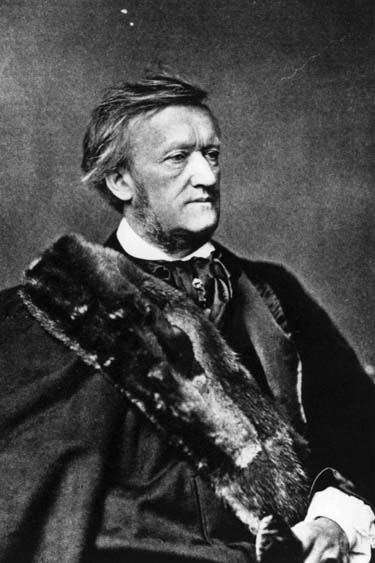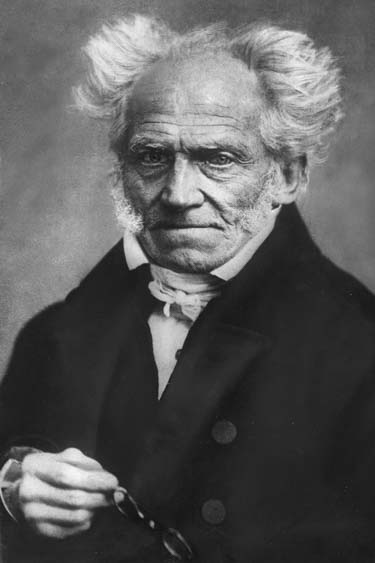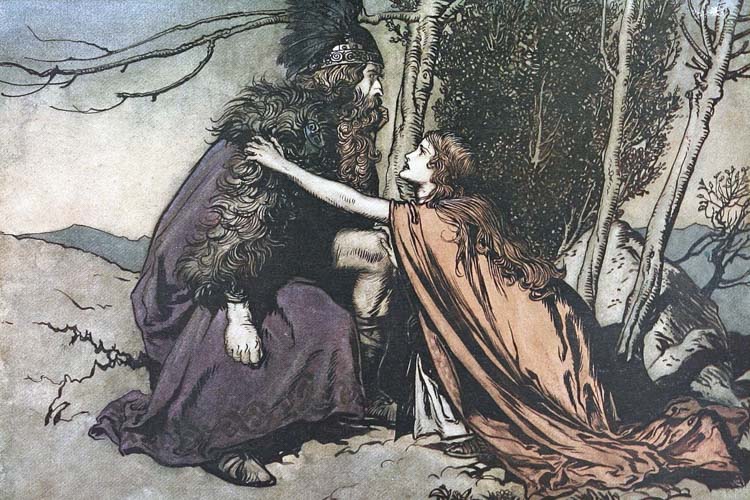April 09, 2020
Philosophy and the RING
No great artist simply applies philosophical teaching. But Wagner read philosophy passionately, personally, and allowed what he read to reverberate against his own creative instincts. Two philosophers popular in his time clearly guided Wagner as he shaped and reshaped his Ring. In the end, though, Wagner created a tragic drama that is all his own, focusing on the nature of love, its glory and its tragedy.

Richard Wagner
The Ring was composed between 1848 and 1874, and first performed as a cycle in 1876. By 1851 Wagner had planned a cycle of four operas, the first two bearing the titles they still have, followed by The Young Siegfried and Siegfried’s Death. The text for all four parts was completed in 1852 and privately published in 1853. Between 1853 and 1857, Wagner composed the first two operas and the first two acts of the third. Then he stopped, setting the entire work aside for twelve years. In 1869–after writing Tristan und Isolde (1865) and Die Meistersinger von Nürnberg (1868)–he took it up again, changing the ending to a tragic one. Instead of being taken to Valhalla by Brünnhilde, Siegfried is killed on earth, Valhalla is destroyed, and Brünnhilde ends her own life.
Wagner’s “muse” in the earlier compositional period was Ludwig Feuerbach (1804-1872). A strong influence on Marx, Engels, and other social revolutionaries, Feuerbach was a radical opponent of both class inequality and traditional religion. He defends a type of secular humanism, and views religion as a confused projection into the beyond of elements of human nature. Instead of remaining imprisoned by other-worldly thinking, we need a philosophy that focuses on human need and encourages the expression of love.

Ludwig Feuerbach
Wagner resonated strongly with Feuerbach’s social radicalism, which provided the work with its ending in early drafts. The loving couple end up in Valhalla, which is consumed by fire along with them – but the gods’ order is to be replaced by a human “world without rulers,” under the sway of love. Wagner ultimately discarded this ending; but there is still a lot in the Ring that is Feuerbachian: the strong condemnation of greed, the structuring contrast between greed/domination (Alberich, Hunding, Hagen) and love (Siegmund-Sieglinde, Brünnhilde). During the long compositional gap, however, Wagner steeped himself in the work of another philosopher whose ideas moved him powerfully, in ways totally opposite to the radical emancipatory vision of Feuerbach. That philosopher was Arthur Schopenhauer (1788-1860), author of The World as Will and As Representation (1818), an eloquent work of extreme misanthropy that was all the rage in Wagner’s time.

Arthur Schopenhauer
For Schopenhauer, the world contains two forces that manifest themselves everywhere. One is “Representation,” through which objects appear to a perceiving subject. (Schopenhauer thought that we never attain knowledge of things in themselves, only of interpretations or representations of them.) That capacity is benign, and we can use it to study the world. But we are also driven, like everything in nature, by a dynamic erotic force that is often felt as desire, and that leads above all to the continuation of life. This force, which he called “Will,” is the cause of endless and unmitigated suffering. Influenced strongly by Buddhism, Schopenhauer thought that the only remedy for life’s pain was resignation, ceasing to want. We must resist all of life’s lures as so many fetters that bind us to pain. (He thought women were prominent among such lures, hence his intense misogyny.) The function of art, he held, is to make the hopelessness of life indelibly clear to us so that, grasping this truth in a calm moment, we can embark on the path of resignation.
Wagner certainly imbibed some of this pessimism. Parsifal has a lot of it, in a Christian form; both the negative portrait of Klingsor’s realm and the emphasis on Parsifal’s purity suggest a negative judgment on sexuality. Tristan has unmistakable Schopenhauerian elements, in its depiction of the unrealizable and hopeless longing and striving that erotic love involves; but the opera presents a more sympathetic and complicated view of love than Schopenhauer would have approved. In Meistersinger, Hans Sachs expresses Schopenhauerian ideas in his weary monologue, but these sentiments, though crucial to Sachs’s emotion as he understands that he must give up his love for Eva, are not those of the work as a whole, as interpreters from Nietzsche to Thomas Mann have noticed.
What of the Ring? Certainly Wagner substituted a tragic ending for the original happy humanistic ending. But is it an ending that judges human life devoid of meaning and value, as Schopenhauer would demand? For it does seem right to view the Ring as all about the question of life’s meaning, in one way or another. However, we should not hastily assume that the Schopenhauerian answer to this question is the one that finally satisfies Wagner. The ending clearly focuses on the fate of love in the world, and on the evolution of Brünnhilde’s grasp of love. But how? We must back up in order to set her development in context.
The Ring begins with an innocent natural realm, without laws or contracts, and, crucially, without deep love. Its beings have simple instinctual emotions, sexual desire and reactive anger. But they have neither compassionate love nor deep erotic love. This natural realm is not a purely good realm, and even its attractive parts are superficial. Wotan wants to transform it: how?
Wotan’s first plan is to transform the world through law and contracts. But, keen on domination, he makes a mess of things, breaking his promise to the giants. Moreover, he doesn’t understand that the rule of law needs citizens who are independent and not mere proxies for his will: the Valkyries have no autonomy and are just extensions of him.
In a second phase, Wotan changes course and strives for a world under the sway of love, as exemplified by Sieglinde and Siegmund. Again, this project has not been well thought through, and, under pressure from Fricka, Wotan proves unable to carry it out. However, this love proves the linchpin of the plot, because through it Brünnhilde begins her journey toward both autonomy and human love, in all its richness and its tragic complexity. Let us, then, study the stages in her comprehension and experience of love. This will allow us to understand, ultimately, how far Schopenhauerian pessimism rules the world of the Ring.
Initially, Brünnhilde is the hoydenish Valkyrie, her strength untainted by sorrow. She is not human, and she lacks understanding of human suffering. At this point she cannot even have compassionate love.
Then she encounters Siegmund. She offers him the chance to go to Valhalla with her, but tells him he must give up Sieglinde. He flatly and unequivocally refuses. “Then greet Valhalla for me…Where Sieglinde lives, in joy or pain, there must Siegmund live with her.” Brünnhilde is shocked, almost uncomprehending: “So you would sacrifice joy everlasting? Is she all in the world to you, that maid who lies there limp and afraid in your arms?”
At this stage her grasp has expanded. Her surprise and awe at his sacrifice opens up new depths in her, and she feels compassion. She sees a love that as yet she cannot fully comprehend or feel in herself, but she sees that it matters. She now decides to save Siegmund, defying Wotan and separating her will from his. Her plan is frustrated, but her autonomous choice sets in motion the train of events that lead to her becoming mortal and falling in love with Siegfried. So far, then, she has not experienced human love, rooted in human finitude; but compassion has opened a space in her.

On the way, there is a key moment, as she cares for Sieglinde in the forest. Sieglinde tells Brünnhilde of her pregnancy and the hero who will be born. Brünnhilde experiences a transcendent surge of emotion, both about the mother’s love and, I think, about her own love to come. She decides that one thing she can and must do is to save the child: “Siegfried in triumph shall live.” Hearing this, Sieglinde then sings a soaring theme of great beauty, expressing the wondrous nature of Brünnhilde’s choice: “O most sublime wonder. Most glorious maiden.” This is a pivotal moment in the drama as a whole. Even though Wagner wrote it before he discovered Schopenhauer, it ultimately becomes the key to his response to Schopenhauer’s pessimism.
Newly mortal on the mountain, she feels a love whose erotic intensity is new to her, though she had witnessed it from the outside. But the lovers, giddy and isolated from the world, do not yet know of love’s worldly complexity. The bitter lesson of the final opera is that human love is finite in two ways. It is finite because human beings die: that’s the easy lesson. But it is finite from the inside as well. When lovers live in a corrupt world, the world corrupts love. In Siegfried the world generates not only betrayal but, still worse, a mingling of love with violence, as, in Götterdämmerung, he shows an ugly desire for rape. The world of manly heroism is not the answer to the work’s search for meaning, since male heroism has ugliness in it—so, at least, we may try to comprehend this troubling aspect of the work, one of its biggest barriers for a modern audience. In Brünnhilde, the world’s corruption engenders rage and a passion for a retribution even more powerful than her grief. This is not just an external tragedy: it mars the nature of her love itself, as she wills Siegfried’s death.
Human love, then, is not just finite, hedged round with danger and inevitable death. It is also imperfect internally. Seeing this, Brünnhilde, were she a disciple of Schopenhauer, would conclude that it is worthless, a mere guise for the base animal instinct of reproduction. However, this is clearly not what Brünnhilde concludes. As she prepares to ride her horse into the funeral pyre, joining Siegfried, she asserts the imperfect nature of their love, but asserts, at the very same time, its great beauty: Siegfried was “the purest one, the one who betrayed me...the truest of lovers, none falser than he.” Squalor and beauty live together in human love, but the squalor does not negate the beauty. She joins him in death as a final testimony to their love’s beauty, and her final words assert the worth of a human happiness: “See, Siegfried: blissful, your wife greets you.”
It is fitting that Wagner’s final commentary on human love is given by his music, after all words are at an end. As the two lovers are consumed by fire, as Hagen—who sings the work’s final words, “Give back the ring”—is frustrated, and the ring is back again with the Rhinemaidens, we hear surging up from the orchestra the theme Sieglinde sang to the words “O most sublime wonder,” as if it is a final statement of some type. The theme is often called the “redemption through love” motif, but Wagner said he would rather call it the “glorification of Brünnhilde.” Its presence at the end of the work tells us that by participating fully and unreservedly in love, despite its limits and its internal imperfection, Brünnhilde achieves the only sort of “glorification” human life admits. Our world is not exactly “redeemed”: that would be too otherworldly. But it is vindicated: despite its imperfection, human love makes life worth living.
Martha C. Nussbaum is the Ernst Freund Distinguished Service Professor of Law and Ethics at the University of Chicago. This article was written for the program of Lyric's Die Walküre (2017/18).
